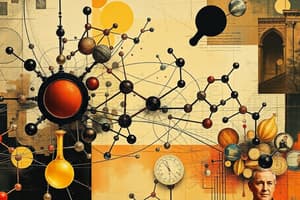Podcast
Questions and Answers
What is the pH of the solution after 50.0 mL of NaOH was added to a 200.0 mL solution of 0.40 M ammonium chloride?
What is the pH of the solution after 50.0 mL of NaOH was added to a 200.0 mL solution of 0.40 M ammonium chloride?
- 9.25 (correct)
- 4.75
- 5.02
- 8.98
What is the oxidation number of chromium in ammonium dichromate, (NH4)2Cr2O7?
What is the oxidation number of chromium in ammonium dichromate, (NH4)2Cr2O7?
- +4
- +6 (correct)
- +3
- +5
Which statement accurately describes reduction in a chemical context?
Which statement accurately describes reduction in a chemical context?
- Gain of protons
- Loss of mass
- Gain of electrons (correct)
- Loss of electrons
Which cell diagram accurately represents the voltaic cell generated by the reaction of zinc with lead ions?
Which cell diagram accurately represents the voltaic cell generated by the reaction of zinc with lead ions?
In the construction of a voltaic cell with Ag(CN)2- and Cr, which of the following cell diagrams is correct?
In the construction of a voltaic cell with Ag(CN)2- and Cr, which of the following cell diagrams is correct?
Which half-reaction indicates that Pb is a stronger oxidizing agent than Au?
Which half-reaction indicates that Pb is a stronger oxidizing agent than Au?
Which of the following species can act as a better reducing agent than Al?
Which of the following species can act as a better reducing agent than Al?
Which statement is correct based on the half-reactions provided?
Which statement is correct based on the half-reactions provided?
Which half-reaction shows a species that can be readily reduced?
Which half-reaction shows a species that can be readily reduced?
Which of the following species is a better oxidizing agent than I2?
Which of the following species is a better oxidizing agent than I2?
Which sodium salt solution will exhibit the highest pH and therefore be the most basic?
Which sodium salt solution will exhibit the highest pH and therefore be the most basic?
What is the pH of coffee with a hydroxide ion concentration of $1 imes 10^{-10}$ M?
What is the pH of coffee with a hydroxide ion concentration of $1 imes 10^{-10}$ M?
What is the hydronium ion concentration of a $0.010$ M acetic acid solution?
What is the hydronium ion concentration of a $0.010$ M acetic acid solution?
What is the concentration of [OH–] in a $0.20$ M ammonia solution?
What is the concentration of [OH–] in a $0.20$ M ammonia solution?
Which expression can be used to calculate the hydronium ion concentration for weak acids with small Ka values?
Which expression can be used to calculate the hydronium ion concentration for weak acids with small Ka values?
Which salt forms an aqueous solution with a pH = 7?
Which salt forms an aqueous solution with a pH = 7?
What mole ratio of Na2HPO4/NaH2PO4 is necessary to produce a buffer solution with a pH of 7.4?
What mole ratio of Na2HPO4/NaH2PO4 is necessary to produce a buffer solution with a pH of 7.4?
What relationship holds at the halfway point to the equivalence point in a titration curve of a weak acid with a strong base?
What relationship holds at the halfway point to the equivalence point in a titration curve of a weak acid with a strong base?
What is defined as the energy transferred due to a temperature difference?
What is defined as the energy transferred due to a temperature difference?
If ΔSsys is negative during a spontaneous chemical reaction, what does this imply about ΔSsurr?
If ΔSsys is negative during a spontaneous chemical reaction, what does this imply about ΔSsurr?
What can be inferred about the entropy change when sodium hydroxide dissolves in water, resulting in a temperature rise?
What can be inferred about the entropy change when sodium hydroxide dissolves in water, resulting in a temperature rise?
Which of the following statements about reaction rates and kinetic molecular theory is false?
Which of the following statements about reaction rates and kinetic molecular theory is false?
What is the nature of the steps that make up a reaction mechanism?
What is the nature of the steps that make up a reaction mechanism?
In a proposed mechanism for ozone decomposition, which species is classified as an intermediate?
In a proposed mechanism for ozone decomposition, which species is classified as an intermediate?
What is likely to happen to the reaction rate as the concentration of reactants decreases over time?
What is likely to happen to the reaction rate as the concentration of reactants decreases over time?
What does it mean if the entropy change of the system is greater than zero?
What does it mean if the entropy change of the system is greater than zero?
What is the value of $ riangle G^{ heta}$ for the reaction forming ammonia at 298 K?
What is the value of $ riangle G^{ heta}$ for the reaction forming ammonia at 298 K?
What is the overall order of the reaction 2 NO(g) + Cl2(g) → 2 NOCl(g) based on experimental data?
What is the overall order of the reaction 2 NO(g) + Cl2(g) → 2 NOCl(g) based on experimental data?
What is the half-life of a first-order reaction with a rate constant of 3.45 x 10^-3 s^-1?
What is the half-life of a first-order reaction with a rate constant of 3.45 x 10^-3 s^-1?
In the acid-base reaction CH3NH2 + HSO4– ⇄ CH3NH3+ + SO42–, identify the acid reactant.
In the acid-base reaction CH3NH2 + HSO4– ⇄ CH3NH3+ + SO42–, identify the acid reactant.
What is the pH of a buffer solution where [HA] = [A–]?
What is the pH of a buffer solution where [HA] = [A–]?
What is the rate of reaction of nitrogen monoxide and hydrogen in mols/s?
What is the rate of reaction of nitrogen monoxide and hydrogen in mols/s?
Which reaction path indicates the effect of a catalyst?
Which reaction path indicates the effect of a catalyst?
What is the value of Ecell for a concentration cell with silver electrodes at 0.10 M and 0.00003 M silver nitrate?
What is the value of Ecell for a concentration cell with silver electrodes at 0.10 M and 0.00003 M silver nitrate?
How many seconds does it take for the concentration of formic acid to decrease by 87.5%?
How many seconds does it take for the concentration of formic acid to decrease by 87.5%?
Determine the rate expression for the reaction A + B → C based on the provided initial rate data.
Determine the rate expression for the reaction A + B → C based on the provided initial rate data.
Which reaction pathway shows the effect of a catalyst on an uncatalyzed reaction?
Which reaction pathway shows the effect of a catalyst on an uncatalyzed reaction?
What is the rate constant for a second-order reaction if the concentration decreases from 1.00 M to 0.43 M in 75 seconds?
What is the rate constant for a second-order reaction if the concentration decreases from 1.00 M to 0.43 M in 75 seconds?
What happens to concentrations at equilibrium when K >> 1?
What happens to concentrations at equilibrium when K >> 1?
Which statement is true regarding the concentration of products at equilibrium?
Which statement is true regarding the concentration of products at equilibrium?
What must be true if the forward and reverse rate constants are unequal?
What must be true if the forward and reverse rate constants are unequal?
What is the effect of an increase in temperature on the equilibrium constant K?
What is the effect of an increase in temperature on the equilibrium constant K?
Flashcards
Energy transferred due to temperature difference
Energy transferred due to temperature difference
Heat is the energy transferred between objects due to a temperature difference.
Spontaneous reaction with ΔSsys < 0
Spontaneous reaction with ΔSsys < 0
If the system's entropy decreases (ΔSsys < 0) during a spontaneous reaction, the surroundings' entropy must increase (ΔSsurr > 0) to compensate and make the overall entropy change positive.
NaOH dissolving in water
NaOH dissolving in water
When NaOH dissolves in water, the system's entropy increases (ΔSsys > 0) because the ions become more dispersed. The increase in temperature means heat is released to the surroundings (ΔSsurr > 0).
Reaction rate and concentration
Reaction rate and concentration
Signup and view all the flashcards
Reaction mechanism
Reaction mechanism
Signup and view all the flashcards
Reaction intermediate
Reaction intermediate
Signup and view all the flashcards
Elementary step
Elementary step
Signup and view all the flashcards
Reaction rate and reactants
Reaction rate and reactants
Signup and view all the flashcards
pH of coffee
pH of coffee
Signup and view all the flashcards
Hydronium ion concentration of acetic acid
Hydronium ion concentration of acetic acid
Signup and view all the flashcards
Ammonia solution concentration
Ammonia solution concentration
Signup and view all the flashcards
Weak acid hydronium ion calculation
Weak acid hydronium ion calculation
Signup and view all the flashcards
pH of salt solution
pH of salt solution
Signup and view all the flashcards
Buffer solution pH calculation
Buffer solution pH calculation
Signup and view all the flashcards
Sodium phosphate mole ratio
Sodium phosphate mole ratio
Signup and view all the flashcards
Most basic sodium salt solution
Most basic sodium salt solution
Signup and view all the flashcards
pH at Equivalence Point
pH at Equivalence Point
Signup and view all the flashcards
Titration Calculation
Titration Calculation
Signup and view all the flashcards
Reduction
Reduction
Signup and view all the flashcards
Oxidation Number of Chromium
Oxidation Number of Chromium
Signup and view all the flashcards
Voltaic Cell Diagram
Voltaic Cell Diagram
Signup and view all the flashcards
Standard Reduction Potential
Standard Reduction Potential
Signup and view all the flashcards
Oxidizing Agent
Oxidizing Agent
Signup and view all the flashcards
Reducing Agent
Reducing Agent
Signup and view all the flashcards
Stronger Reducing Agent
Stronger Reducing Agent
Signup and view all the flashcards
Electrochemical Cell
Electrochemical Cell
Signup and view all the flashcards
Reaction Rate Conversion
Reaction Rate Conversion
Signup and view all the flashcards
Catalyst Effect
Catalyst Effect
Signup and view all the flashcards
First-Order Kinetics
First-Order Kinetics
Signup and view all the flashcards
Second-Order Rate Constant
Second-Order Rate Constant
Signup and view all the flashcards
Equilibrium Constant (K)
Equilibrium Constant (K)
Signup and view all the flashcards
Equilibrium: Rate of Reaction
Equilibrium: Rate of Reaction
Signup and view all the flashcards
Rate Constants at Equilibrium
Rate Constants at Equilibrium
Signup and view all the flashcards
Oxidizing and Reducing Agents
Oxidizing and Reducing Agents
Signup and view all the flashcards
Gibbs Free Energy
Gibbs Free Energy
Signup and view all the flashcards
Reaction Order
Reaction Order
Signup and view all the flashcards
Half-Life
Half-Life
Signup and view all the flashcards
Acid-Base Reaction
Acid-Base Reaction
Signup and view all the flashcards
Buffer Solution pH
Buffer Solution pH
Signup and view all the flashcards
Concentration Cell
Concentration Cell
Signup and view all the flashcards
Rate Law Determination
Rate Law Determination
Signup and view all the flashcards
Study Notes
Summary of Chemistry Concepts
- Reduction: The gain of electrons in a chemical reaction.
- Oxidation: The loss of electrons in a chemical reaction.
- Voltaic Cell: A galvanic cell producing electricity from a spontaneous redox reaction.
- Cell Diagram: A shorthand notation representing a voltaic cell.
- Standard Reduction Potential (E°): The tendency of a species to be reduced in a half-reaction under standard conditions.
- Nernst Equation: Used to calculate the cell potential under non-standard conditions.
- Reaction Quotient (Q): A measure of the relative amounts of products and reactants present in a reaction at any given time.
- Equilibrium Constant (K): A value that represents the ratio of products to reactants at equilibrium.
- Equilibrium: The state where the rates of the forward and reverse reactions are equal, and the concentrations of reactants and products no longer change significantly.
- pH: A measure of the hydrogen ion concentration in a solution, signifying acidity or basicity. A measure for the acidity of the solution.
- Reaction Order: The dependence of a reaction rate on the concentration of reactants.
- Rate constant(k): A proportionality constant that relates the rate of a reaction to the concentrations of reactants
- Half-life (t1/2): The time required for the concentration of a reactant to decrease to half its initial value in a chemical reaction.
- Buffer Solution: A solution that resists changes in pH upon addition of small amounts of acid or alkali.
- Solubility Product Constant (Ksp): Measure of solubility of a solid ionic compound.
Studying That Suits You
Use AI to generate personalized quizzes and flashcards to suit your learning preferences.




